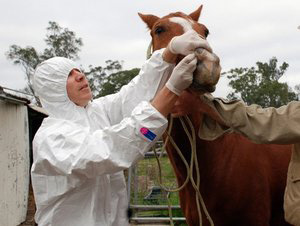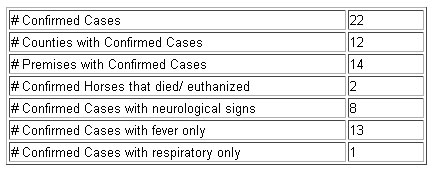California: EHV-1 Contained
By Staff Report June 21, 2011With no new confirmed EHV-1 cases since June 3, the California Department of Food and Agriculture on June 20 declared the outbreak contained. Containment is based on the fact that California has gone more than 14 days from the last clinical onset date without any new confirmed cases.
 The neuropathogenic strain of Equine Herpes Virus-1 resulted in only two equine deaths in California, where 22 cases were tracked, but the economic impact to horse shows, trainers, and other equine-related businesses was far greater than those numbers indicate. The state went into virtual lockdown over fear of the disease.
The neuropathogenic strain of Equine Herpes Virus-1 resulted in only two equine deaths in California, where 22 cases were tracked, but the economic impact to horse shows, trainers, and other equine-related businesses was far greater than those numbers indicate. The state went into virtual lockdown over fear of the disease.
Although EHV-1 was initially traced to horses that attended the National Cutting Horse Association’s Western National Championships, April 27-May 8 in Ogden, Utah, the fear pervaded every discipline, from jumpers to polo and dressage. Horse owners and facility overseers went into a panic over potential infiltration. Some stable managers went so far as to discourage contact with “unknown” horses by telling boarders that if they removed their animals from the premises they would not be re-admitted until the danger passed.
California’s state veterinarian Dr. Annette Whiteford indicated that a conscientious response from owners minimalized the impact of the disease. “I want to thank California’s horse owners and veterinarians for their prompt and thorough actions to isolate and monitor exposed animals and contain this outbreak of EHV-1,” Whiteford said. “We also owe the success of this project in part to the outstanding isolation biosecurity measures implemented by horse facility managers, show/event managers and other professionals who work with and care for horses.”
While the CDFA did issue the all-clear, it also imparted a stern reminder that “California horse owners remain vigilant” and continue to apply “consistent, basic biosecurity practices” that will prevent the spread not only of EHV-1, but more common illnesses such as influenza, strangles and pigeon fever.
These measures include:
• Minimize horse nose-to-nose contact with horses of unknown disease status.
• Don’t share equipment including buckets, tack and grooming equipment.
• Avoid using communal water troughs.
• Fill water buckets directly from the faucet to eliminate potential hose contamination.
• Limit human contact between horses or wash hands or use hand sanitizer between horse contacts.
• Prior to returning home from an event, clean and disinfect all equipment, including trailer, clothing,
tack grooming supplies.
• Isolate all new horses or horses returning home for a minimum of three weeks. Isolation means no direct
contact with other horses or humans and no indirect contact via shared equipment.
• Consult your veterinarian to establish appropriate vaccination for your horse(s).
Horse owners are strongly encouraged to consult their veterinarian regarding these steps and others to
determine how best to reduce the risk of your horse acquiring an infectious disease.
For more CDFA information, including a FAQ and Situation Report, click here.
Short URL: https://theequestriannews.com/?p=3164



